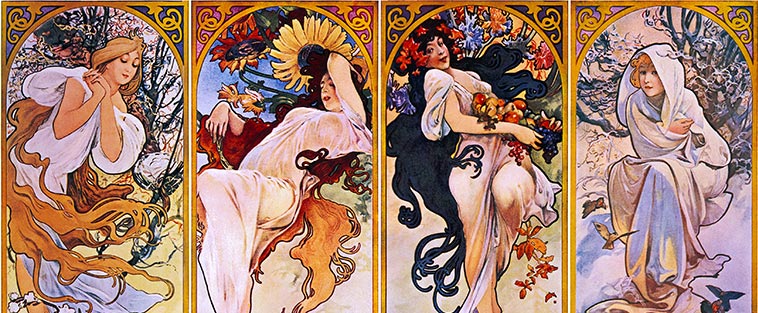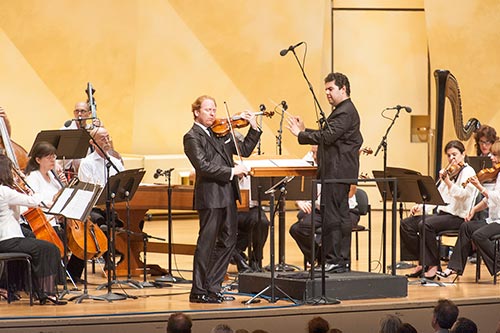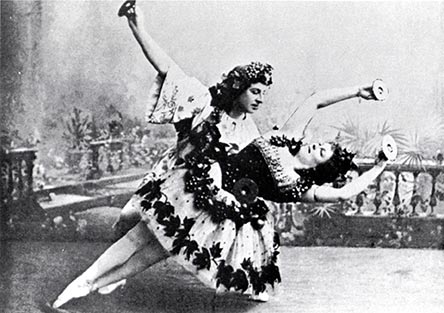
By John Schauer
If a beauty pageant was held for the orchestral works of the Baroque period, odds are the hands-down winner would be Antonio Vivaldi’s The Four Seasons, the set of four violin concertos that the Cleveland-based Baroque orchestra Apollo’s Fire will perform in the Martin Theatre on July 27, replete with the period flavor of their 1725 publishing. Probably the only works that might come close in a popular vote would be Bach’s “Brandenburg” Concertos and Handel’s Water Music, but Vivaldi’s Four Seasons have entered the collective consciousness as few musical works ever have.
It wasn’t always that way; like most music composed before 1750, Vivaldi’s works were virtually forgotten until the chance discovery of his personal collection of his manuscripts in 1926 awakened scholarly interest. And The Four Seasons themselves didn’t become really popular until violinist Louis Kaufmann performed them on a CBS Radio broadcast in 1950. Since then, movements from the set have been used in literally hundreds of films, from 1967’s Elvira Madigan to last year’s box-office hits Sing and The Secret Life of Pets, and in television series as diverse as The Sopranos, American Horror Story, It’s Always Sunny in Philadelphia, and The Simpsons—not to mention countless TV commercials.

They have been recorded well over a hundred times, and it is a testimony to the endurance of Vivaldi’s music that they have withstood a dazzling range of performance styles, everything from full symphonic performances conducted by the likes of Leopold Stokowski and Eugene Ormandy to middle-of-the-road readings by such ensembles as I Musici or the Academy of St. Martin in the Fields to today’s trendy interpretations on “authentic” period instruments. They have also been the subject of myriad reinterpretations, such as a 1977 recording by The New Koto Ensemble of Japan or a salsa arrangement entitled Los Sazones, which trombonist Jimmy Bosch performed at Ravinia with his band Salsa Dura in conjunction with Baroque specialist Nicholas McGegan conducting members of the Chicago Symphony Orchestra in 2003. Commissioned by Ravinia President and CEO Welz Kauffman, the arrangement proved so popular that it returned the following festival season in 2004. More recently at Ravinia, in 2013, violinist Daniel Hope, conductor Tito Muñoz, and the Chicago Philharmonic performed a radical deconstruction by Max Richter, whose minimalist score incorporates snippets of Vivaldi’s score along with electronica and found sounds.
Such breadth vividly demonstrates the phenomenal popularity of The Four Seasons, but doesn’t explain it. Strange as it may sound, it probably isn’t the music itself that accounts for it. Think about it: How likely is it that the musical world actually compared these four concertos to the more than 500 that Vivaldi composed, and then decided these were the best? The Four Seasons, in fact, weren’t published as a simple collection of four concertos; in the 18th century, composers usually published works in six-packs, like beer, or by the dozen, like jelly donuts. The Four Seasons were just the first four concertos in a collection of 12 published by Vivaldi under the title Il cimento dell’ armonia e dell’ inventione, “The Contest Between Harmony and Invention.” How many music listeners are familiar with numbers 5 through 12? Are we expected to believe that the first four of that collection are so vastly superior to the eight that followed them?

Johann Sebastian Bach had great interest in the music of Vivaldi, and his own instrumental concertos are modeled on the form established by his predecessor—usually in three movements with the first and last movement in “ritornello” form, in which an introductory musical statement is repeated throughout, sometimes only in fragments, in different keys, the iterations separated by freely composed flights of fancy. Bach even made solo keyboard arrangements of seven of them—but didn’t select any from The Four Seasons.
So why are audiences so crazy about those four concertos today? Without denying any of Vivaldi’s genius and inventiveness as a composer, a non-musical reason might have exerted a major influence: the power of a title. Consider the blank look you are apt to get if you ask a friend their opinion of Beethoven’s opus 27, number 2. But his or her face will light up with recognition if you ask the same question about the “Moonlight” Sonata. That name wasn’t even attached to the piano piece until after Beethoven’s death, but it has become how it is known universally.
The title, even the subject, of the four seasons has a great deal of appeal and served as inspiration to countless works of art—graphic, literary, and musical. In 1726, one year after Vivaldi’s concertos were published, the Scottish poet James Thomson began a massive pastoral poem bearing the title The Seasons. Beginning with “Winter,” Thomson’s poem was published in installments, with a complete edition appearing in 1730. It was translated no fewer than five times into German and is best known to music lovers today as the basis for Haydn’s 1801 oratorio Die Jahreszeiten (The Seasons), one of two such choral masterpieces that crowned the spectacular sunset of Haydn’s career. [The other, The Creation, will be carefully shaped into existence by James Levine and the Chicago Symphony Orchestra and Chorus on August 8.] But Thomson’s original English prose had been used some 60 years earlier for another oratorio of the same name by John Christopher Smith. (He is sometimes confused with his father, who bore the same name and served for most of his life as the copyist for George Frideric Handel.) Where Haydn’s oratorio is divided into four sections, each celebrating one of the seasons, Smith’s work is based on the summarizing “Hymn on the Seasons” that concludes Thomson’s poem and focuses less on the individual seasons and more on the entire yearly cycle as a reflection of God’s creative power and benevolence to mankind.

In 1899 Russian composer Alexander Glazunov joined the staff of the Saint Petersburg Conservatory and in 1905 became the school’s director, a position he somehow managed to retain throughout numerous years of political turmoil. His survival may well have been facilitated by his conservative musical taste; he expressed disgust at the music of Richard Strauss, Stravinsky, and Prokofiev, instead idolizing the music of Tchaikovsky. That predilection is audible in the score he composed during that first year at the conservatory for a one-act ballet called The Seasons, commissioned by the Russian Imperial Ballet with a scenario by the legendary Marius Petipa, who also served as choreographer. The ballet, which received its premiere at the Mariinsky Theater in 1900, has no storyline but is rather a series of four decorative tableaux, along the lines of the second act of Tchaikovsky’s The Nutcracker or the third act of the same composer’s The Sleeping Beauty, both of which were originally choreographed by Petipa. Being a Russian work, it should not surprise us that the first section is devoted to winter, with separate portions depicting the spirits of frost, ice, hail, and snow.
Tchaikovsky himself had created a work known in English as The Seasons, but its form was considerably different. The project had begun in 1875, when Tchaikovsky was approached by the editor of a Saint Petersburg music magazine to write a piano work in 12 movements, each to be published in consecutive months throughout 1876. Each movement was headed by short poetic texts by nine Russian writers, Pushkin and Tolstoy among them, just as Vivaldi had provided short poems to introduce each of his four concertos.
The idea of expressing the progression of the seasons month-by-month was also adopted by another admirer of Tchaikovsky, the Russian composer Mikhail Bronner, since 2001 a professor at Moscow’s Ippolitov Institute of Music. Composed in 1992 in an almost impressionistic style, his work was originally scored for a quintet consisting of piano, violin, cello, flute, and clarinet, but reappeared in a version for string quartet with flute and clarinet in 2007 and has been performed and recorded in a further arrangement for chamber orchestra.
A further set of four seasons compositions, although one not originally intended to be performed as a set, has made the same transition from quintet to numerous other instrumental configurations: Astor Piazzolla’s Las Cuatro Estaciones Porteñas, “The Four Seasons of Buenos Aires.” The first section to be composed was Summer, as incidental music for a play in 1965; Autumn was written in 1969, with both Spring and Winter appearing in 1970. All four movements are tangos, and each movement was first performed by Piazzolla’s signature quintet of violin or viola, piano, electric guitar, double bass, and bandoneón. Most listeners—at least those not familiar with urban life in Buenos Aires—might not be able to identify the specific seasons by the music, but some of the myriad orchestrations of each have helped put them in context. In 2000, violinist and frequent Piazzolla collaborator Gidon Kremer recorded them in an arrangement for string orchestra by Leonid Desyatnikov that injects quotes from Vivaldi, and interspersed them with Vivaldi’s originals on a disc he called The Eight Seasons.
A clear sense of season attribution is even more absent in Philip Glass’s Violin Concerto No. 2, which was created for violinist Robert McDuffie as a companion piece to Vivaldi’s Four Seasons concertos and subtitled “The American Four Seasons.” During composition, however, differences of opinion developed between Glass and McDuffie as to which movement signified which season, and Glass ultimately decided to let listeners make up their own minds. As a result, the sections are not named after the seasons but simply as Movement I, Movement II, and so forth, with an introductory prelude and three solo violin “songs” that precede each of the last three sections.
The subject of the four seasons has attracted a rather incredible diversity of composers: it was the inspiration for the first orchestral work created by John Cage, the score to a ballet called The Seasons with choreography by Merce Cunningham. The choreography is unfortunately lost, but Cage’s score prefigured Glass’s concerto by having introductory preludes before each of the four main sections, with the first prelude reprised as a finale for a total of nine movements.

If you’re mildly surprised to find a “seasons” composition by John Cage, known for his use of aleatoric procedures and philosophical concept music, you may be flabbergasted to learn that the same subject hit dance floors in 1976, when disco queen Donna Summer released her fourth album, The Four Seasons of Love. Produced and composed by Giorgio Moroder and Pete Bellotte, who essentially created the whole Donna Summer phenomenon, the album traverses the progression of a love relationship that begins as a “Spring Affair,” blossoms into a “Summer Fever,” starts to cool down with “Autumn Changes,” and ends in a bitter “Winter Melody,” before love blooms again in a “Spring Reprise.”
It was around that time, while this writer was living in California, that a West Coast publication ran a cartoon showing a couple calling on their friends in a New York City apartment. As they wait for the door to be opened, the wife counsels the husband, “Be sure to mention how much we miss the seasons since we moved to California. It seems to mean a lot to them.” Of course, even in California there are seasons; the changes are just far more subtle than we “enjoy” in the Chicago area, which endures extreme temperature changes over the course of a year—or sometimes seemingly over a single month—greater than just about anywhere in the country.
The exact ways our seasons will be modified due to the global climate change that science has been warning us about are yet to be fully comprehended. If there is any silver lining to be found, perhaps composers in that brave new meteorological world will be able to find inspiration for further musical explorations. One thing is certain: the cyclical nature of weather throughout the year will continue to intrigue us, just as it has inspired composers for the nearly 300 years since Vivaldi penned his signature opus.
The former editor of Ravinia magazine, John Schauer is the author of “The Essentials of Classical Music” on Ravinia’s website.
